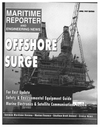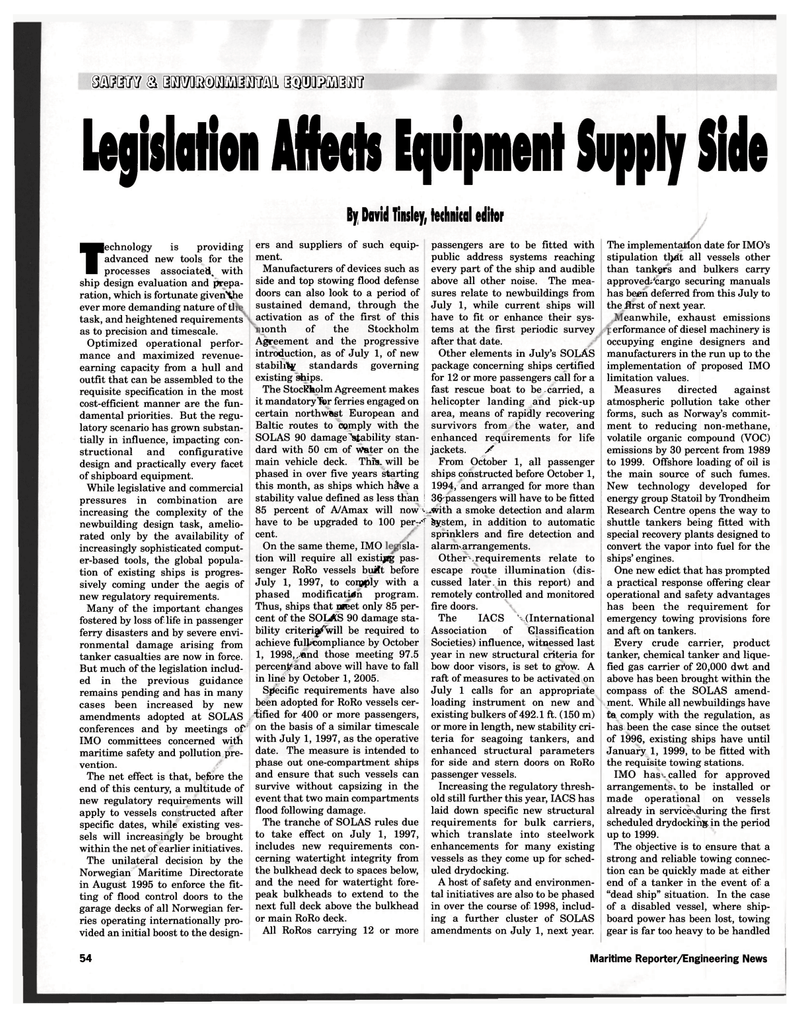
Page 52: of Maritime Reporter Magazine (April 1997)
Read this page in Pdf, Flash or Html5 edition of April 1997 Maritime Reporter Magazine
®mm & iMiiii im^nu
Legislation Affects Equipment Supply Side
By David Tinsley, technical editor
Technology is providing advanced new tools for the processes associated, with ship design evaluation and prepa- ration, which is fortunate given the ever more demanding nature of tl task, and heightened requirements as to precision and timescale.
Optimized operational perfor- mance and maximized revenue- earning capacity from a hull and outfit that can be assembled to the requisite specification in the most cost-efficient manner are the fun- damental priorities. But the regu- latory scenario has grown substan- tially in influence, impacting con- structional and configurative design and practically every facet of shipboard equipment.
While legislative and commercial pressures in combination are increasing the complexity of the newbuilding design task, amelio- rated only by the availability of increasingly sophisticated comput- er-based tools, the global popula- tion of existing ships is progres- sively coming under the aegis of new regulatory requirements.
Many of the important changes fostered by loss of life in passenger ferry disasters and by severe envi- ronmental damage arising from tanker casualties are now in force.
But much of the legislation includ- ed in the previous guidance remains pending and has in many cases been increased by new amendments adopted at SOLAS conferences and by meetings of
IMO committees concerned with maritime safety and pollution pre- vention.
The net effect is that, before the end of this century, a multitude of new regulatory requirements will apply to vessels constructed after specific dates, while existing ves- sels will increasingly be brought within the net of earlier initiatives.
The unilateral decision by the
Norwegian Maritime Directorate in August 1995 to enforce the fit- ting of flood control doors to the garage decks of all Norwegian fer- ries operating internationally pro- vided an initial boost to the design- ers and suppliers of such equip- ment.
Manufacturers of devices such as side and top stowing flood defense doors can also look to a period of sustained demand, through the activation as of the first of this lonth of the Stockholm
Agreement and the progressive introduction, as of July 1, of new stability standards governing existing ships.
The Stockholm Agreement makes it mandatory for ferries engaged on certain northwest European and
Baltic routes to comply with the
SOLAS 90 damage 'stability stan- dard with 50 cm of Water on the main vehicle deck. This will be phased in over five years starting this month, as ships which hSve a passengers are to be fitted with public address systems reaching every part of the ship and audible above all other noise. The mea- sures relate to newbuildings from
July 1, while current ships will have to fit or enhance their sys- tems at the first periodic survey after that date.
Other elements in July's SOLAS package concerning ships certified for 12 or more passengers call for a fast rescue boat to be carried, a helicopter landing and pick-up area, means of rapidly recovering survivors from the water, and enhanced requirements for life jackets. /
From October 1, all passenger ships constructed before October 1, 1994, and arranged for more than stability value defined as less than 36 passengers will have to be fitted 85 percent of A/Amax will now • with a smoke detection and alarm have to be upgraded to 100 per-' System, in addition to automatic sprinklers and fire detection and alarm arrangements.
Other requirements relate to escape route illumination (dis- cussed later, in this report) and remotely controlled and monitored fire doors.
The IACS (International sla- cent.
On the same theme, IMO tion will require all existing pas- senger RoRo vessels buHt before
July 1, 1997, to corpply with a phased modification program.
Thus, ships that nreet only 85 per- cent of the SOLAS 90 damage sta- bility criteri^Avill be required to Association of Classification achieve full; compliance by October 1, 1998, and those meeting 97.5 percent and above will have to fall in line by October 1, 2005.
Specific requirements have also been adopted for RoRo vessels cer- tified for 400 or more passengers, on the basis of a similar timescale with July 1, 1997, as the operative date. The measure is intended to phase out one-compartment ships and ensure that such vessels can survive without capsizing in the event that two main compartments flood following damage.
The tranche of SOLAS rules due to take effect on July 1, 1997, includes new requirements con- cerning watertight integrity from the bulkhead deck to spaces below, and the need for watertight fore- peak bulkheads to extend to the next full deck above the bulkhead or main RoRo deck.
All RoRos carrying 12 or more
Societies) influence, witnessed last year in new structural criteria for bow door visors, is set to grow. A raft of measures to be activated on
July 1 calls for an appropriate loading instrument on new and existing bulkers of 492.1 ft. (150 m) or more in length, new stability cri- teria for seagoing tankers, and enhanced structural parameters for side and stern doors on RoRo passenger vessels.
Increasing the regulatory thresh- old still further this year, IACS has laid down specific new structural requirements for bulk carriers, which translate into steelwork enhancements for many existing vessels as they come up for sched- uled drydocking.
A host of safety and environmen- tal initiatives are also to be phased in over the course of 1998, includ- ing a further cluster of SOLAS amendments on July 1, next year.
The implementation date for IMO's stipulation tl>dt all vessels other than tankers and bulkers carry approved cargo securing manuals has been deferred from this July to the first of next year. eanwhile, exhaust emissions erformance of diesel machinery is occupying engine designers and manufacturers in the run up to the implementation of proposed IMO limitation values.
Measures directed against atmospheric pollution take other forms, such as Norway's commit- ment to reducing non-methane, volatile organic compound (VOC) emissions by 30 percent from 1989 to 1999. Offshore loading of oil is the main source of such fumes.
New technology developed for energy group Statoil by Trondheim
Research Centre opens the way to shuttle tankers being fitted with special recovery plants designed to convert the vapor into fuel for the ships' engines.
One new edict that has prompted a practical response offering clear operational and safety advantages has been the requirement for emergency towing provisions fore and aft on tankers.
Every crude carrier, product tanker, chemical tanker and lique- fied gas carrier of 20,000 dwt and above has been brought within the compass of the SOLAS amend- ment. While all newbuildings have to comply with the regulation, as has been the case since the outset of 1996, existing ships have until
January 1, 1999, to be fitted with the requisite towing stations.
IMO has called for approved arrangements to be installed or made operational on vessels already in service during the first scheduled drydocking: in the period up to 1999.
The objective is to ensure that a strong and reliable towing connec- tion can be quickly made at either end of a tanker in the event of a "dead ship" situation. In the case of a disabled vessel, where ship- board power has been lost, towing gear is far too heavy to be handled 54 Maritime Reporter/Engineering News

 51
51

 53
53
